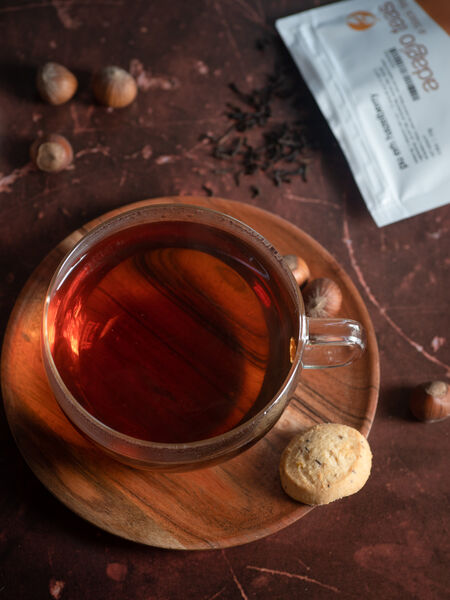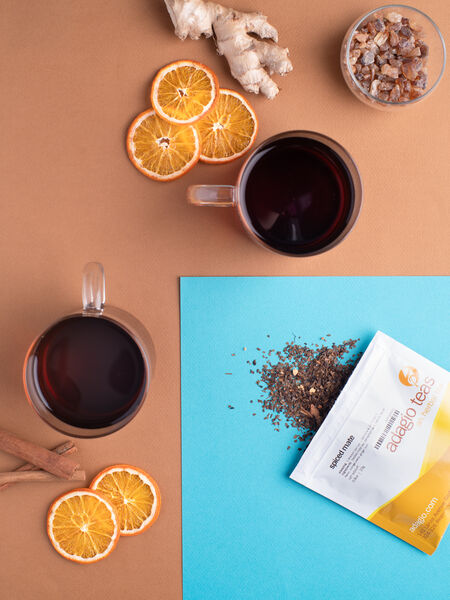Traveling?
A Lovely Place to Stay
Atlanta, Georgia
(airbnb)
Inspired to Serve: A Word for You When your questions pertains to the Holy Writ, seek a commentary from a Brother or a Sister in the Faith, or simply consult with the Holy Spirit:
Traveling?
A Lovely Place to Stay
Atlanta, Georgia
(airbnb)


Tea lovers can always find ways to connect over favorite tea salons, shared passions for certain teas or tea service styles, and of course, one more accessory to enhance the pleasure of tea at home. But what about those friends who are diehard coffee drinkers? How can we convince them that they can have full flavor and aroma, get energized, and a great time to boot drinking tea? One way is to meet them where they are.
Coffee drinkers love the deep rich heartiness of coffee, the intense aroma, the varietals, and different roasts. Many coffee lovers like grinding their own beans and making a ritual making each cup, choosing the best filters, brewer, etc.
For them, the most fascinating tea to suggest is our Shou Pu-Erh with their exceptionally soft, earthy flavor and woodsy complexity, flavors that linger through several steepings. (Coffee lovers can’t re-brew coffee grounds, can they? That means Pu-Erh is a great value, too!)
Our selections of this classic tea from Yunnan, China include natural and flavored ripened Pu-Erh (shou) that are intentionally aged and oxidized before gently dried. The result is a deep, rich body without the signature astringency attributed to many teas. We offer eight choices, including unique flavor combinations like Hazelberry (hazelnuts and berries) and Chorange (chocolate and orange. For the sophisticated, the choice should be our artisanal selection, Pu-Erh Wuliang Green.
Pu-Erh is an integral part of the history of tea where it was carried, sold, bartered, and drunk along the ancient Silk Road. To preserve its integrity, the teas were cleverly shaped into bricks and round cakes. This ingenious step led them to often be used for currency. Share this history or add a little entertainment by entertaining introducing them to our delicious Pu-Erh Pearls. When your friends watch the pearls of tea unfurl in a clear cup or glass pot, they’ll realize that coffee brewing pales in comparison. Of course, no new experience should be approached without the right accessories, so we may we suggest Yixing teapots or gaiwans in which to brew the tea.
For those who choose a beverage based on its health benefits, Pu-Erh is perfect: it’s a natural digestif, perfect after a heavy meal, and is a natural antidote to fatty foods, so much so, that Chinese cooks often use it to clean pots of stir frying. While this does indeed work for the busy chef, we think the best use of Pu-Erh is to drink it. Brew in boiling water (212ºF.) for 5 minutes, and enjoying several steepings of deep flavor to make tea-drinking a welcome after-dinner event for coffee drinkers everywhere.
Do they fear a lack of caffeine? Then get them a packet of Jump Start tea, pronto.
This clever combination of toasted mate and black tea will give anyone a kick of caffeine albeit without the traditional caffeine jitters of plain coffee. Mate (aka Yerba Mate) does indeed have xanthines, in this case mateine, which is absorbed into the body differently than the caffeine in coffee because Jump Start has the theine and L-theobromine from the addition of black tea. Like all true tea, those elements contribute to a feeling of relaxation for the body coupled with mental clarity that’s sure to get them through any deadline or challenge. Best of all, tea neophytes can brew this tea with boiling water (212ºF.) then steep 5 to 10 minutes without sacrificing flavor or adding unwanted astringency. Its nutty flavor is highlighted when using maple syrup, although no sweetening is needed.
Adagio offers other highly caffeinated mates, most of them compiled in this sampler.One alternative, if tea really isn’t their jam, is Coffee Leaf Tea.
Yup, tea brewed with leaves of the coffee plant is now available and it definitely has caffeine, but a moderate amount. We suggest Arabica Mocha made from both the beans and the leaves of the coffee plant.
This drink has been made for centuries in Ethiopia and Indonesia where residents of these stellar coffee-growing countries call it kuti. It has more healthful antioxidants, a mild buzz of caffeine, and classic mocha taste. Arabica Mocha is blended with toasted mate, chicory, and cocoa nibs, with a whisper of hazelnut to offer a nutty, toasty taste with less jitteriness than a drink made solely from the coffee bean and layers of flavors. Brew with boiling water (212ºF.) for 5 minutes. Delish!
Adagio offers a sampler of Arabica teas as well to check out.
If your friends are particularly ambitious, and ready to really try something new, then introduce them to our finest matcha.
This stimulant-laden green tea is made with care and precision from the finest gyokuro green tea grown in the Uji province of Japan and is the “espresso” of tea. To a teaspoon of the powdered matcha tea, add a teaspoon of hot water heated to about 160ºF. Stir to make a paste, then add 4 ounces more of the hot water. Whisk to a froth and serve in a small bowl or cup, and enjoy several sips, just as you would a traditional espresso. With fine matcha, the maxim of quality over quantity is supreme. Using a whisk puts the fun into functional.
online, 4/14/2022
https://www.teamuse.com/article_220204.html
The cradle lands of civilization furnish us with written texts illustrating the use of herbs. The Ebers Papyrus, dating from about 1600 BC, lists some 700 drugs, charms and incantations. The majority of these drugs were herbs. Ancient Babylonian tablets of clay list some 230 commonly used preparations. Finally, the Ancient Chinese during the Shang dynasty (around 1700 BC) were writing texts on herbal medicine. The most famous Ancient Chinese text was a distillate of these early works, written as Shen Nung's Herbal in 273 BC.
The Classical Greeks were responsible for removing much of the magic from the practice of medicine. In particular, Hippocrates mentions some 250 useful herbs in his great works (or at least in the writings attributed to the great physician.) This was later extended by Dioscorides, a Greek physician of the first Century AD, who published his De Materia Medica, which contained over 600 medicinal plants. Hippocrates believed that the four elements, earth, air, fire and water, acted upon by some sort of vital force became activated into humors or Vital Fluids once they had been assimilated and absorbed into the body. There were four Vital Fluids - blood, phlegm, black bile, and yellow bile. He taught that air absorbed through the lungs would be transformed into blood; water would eventually become phlegm; earth (from the substance of food) would become black bile, and heat or fire would become yellow bile.
Aristotle added to this theory the idea of the elements being linked to the Four Qualities of hot, dry, cold and wet, was conceived as being a mixture of two paired qualities. This postulate allowed for the transformation of one element into another, if the predominance of one quality was altered. For example, Fire, which is Hot and Dry, plus Water which is Cold and Wet, could respectively lose Dryness and Coldness to form Earth, which is Cold and Dry; and Air which is Wet and Hot
The second Century physician, Claudius Galen, further refined this theory by linking the Vital Fluids (or humors) and Qualities with the Temperaments of Man. There were thought to be four basic temperaments - sanguine, phlegmatic, melancholic and choleric.
The pure Choleric temperament is generally confident, irascible, touchy and proud. Ambition is usually well developed and there may be arrogance. The Phlegmatic, or lymphatic temperament is fussy, a bit obsessional, practical, but hates the limelight. The Sanguine temperament is excitable, impressionable, impulsive and sometimes unreliable. He can sometimes seem frivolous and thoughtless to others. The Melancholic temperament is cautious, serious, industrious and solitary. There is, of course, a tendency to become depressed.
According to these theories, diseases could be worked out as being hot or cold, moist or dry, or any appropriate combination. Balance could be restored, it was said, by utilizing the Doctrine of Contraries. This meant that a predominantly moist disease could be cured by administering a Dry remedy, whereas a Hot Drug would be most effective against a Cold disease. This system of pharmacology became known as Galenism, after Galen, and the drugs came to be known as Galenicals. Indeed, in our expression - as cool as a cucumber - we see a reference to the use of this simple vegetable as a Galenical.
It is a cooling agent, which has been found to have a scientific rationale, since it is rich in salicylates, which are related to aspirin.
This theory became the major model of medicine for the next millennium and a half, only being disputed as the Renaissance brought the scientific approach to western thinking. However, although herbalism went out of fashion it was never suppressed. As orthodox medicine developed in Europe emigrants to America carried herbal practice with them as they settled the great frontier. Our next significant character was one Samuel Thomson (1769-1843), a self-educated farm boy who learned his herbalism from a local wise woman.
Thomson was wise enough to put his method down on paper in a book which was to become an incredible success. It was decidedly based upon the old humoral theories and the temperaments of herbs and plants. It rapidly spread westwards by a companion to the Bible in the covered wagon trains carrying settlers across the great continent. Unfortunately, physiomedicalism, as the Thomson method became known, met considerable resistance from the rapidly developing American Medical Association towards the end of the nineteenth century. It may even have died out completely had it not been taken back to its roots by emigrants to Britain and Europe. It was a time when the soil was fertile, for the Industrial Revolution had created many great cities where people from the country had been forced to move to gain employment. The new herbalists readily found a market for their skills, since the former country people craved for their old country treatments rather than the expensive new drugs of the orthodox medical profession. Herbalism experienced a renewed popularity, to the extent that the Thomsonian approach was adopted as the basic philosophy of the fledgling organization, the National Association of Medical Herbalists.
This then is a very potted history of Herbal Medicine.